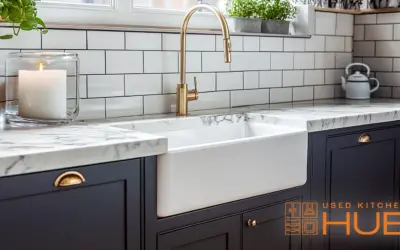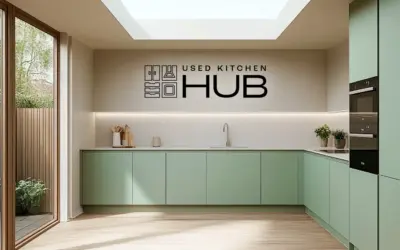Have You Considered Using Refillable Containers—And Why You Should?
Refillable containers aren’t just a trend—they’re a powerful way to cut waste, save money, and champion sustainability. Whether you’re stocking a second-hand kitchen or embracing eco-friendly shopping, here’s a guide packed with smart ideas and insights.
🌍 1. Why Refill, Not Replace?
Massive plastic pollution: The UK’s supermarkets alone generate over 810,000 tonnes of single-use plastic annually (usedkitchenhub.com, usedkitchenhub.com). Globally, 40% of plastic produced is single-use—and most of it ends up in landfills or oceans .
Environmental payoff: Life-cycle assessments show reusable items generally become more eco-friendly than disposables after just a few uses—the “break-even point” (upstreamsolutions.org).
🏪 2. Refillable Options in Everyday Shopping
Dry goods galore: Flour, rice, pasta, lentils—and even fresh meat and fish—are increasingly available by weight or in refillable formats at major supermarkets like Waitrose, Ocado, Aldi, M&S and more (usedkitchenhub.com).
Beyond food: Cleaning liquids, detergents, shampoo, conditioner—and even bulk beauty products—are now offered in concentrate pods or dispenser stations (packagingdigest.com).
Local refillery boom: Independent zero‑waste shops allow you to bring your own containers for food, cleaning and toiletry refills, often complemented by an in‑store “jar library” of shared containers (bhg.com).
💷 3. The Benefits for You and Your Budget
Benefit How it Helps You How it Helps the Planet
Cost-effective Buying in bulk is cheaper per unit (davidsuzuki.org) Less packaging material used
Reduce waste Bring only what you need—no excess spoiling Cuts single‑use plastic and related CO₂ emissions
Convenience Refill at home dispensers—no return trips Easy refill systems encourage sustainable habits
Health & safety Glass or steel won’t leach chemicals Well‑regulated refill providers ensure clean safety
🔧 4. Practical Tips for Kitchen Refill Success
- Choose durable containers
- Opt for glass, stainless steel, or thick PET/HDPE plastics made for reuse.
- Sanitize wisely
- Before each refill, clean jars or bottles with hot, soapy water—and for liquids, sanitize with boiling water or a vinegar rinse.
- Label smartly
- Use reusable labels or chalkboard tags to note contents and date filled—no tape needed.
- Track usage
- Keep containers in rotation until they reach their break-even point—typically 20–60 refills depending on material (theguardian.com, en.wikipedia.org, bhg.com, upstreamsolutions.org).
- Support refill-friendly brands
- Look for stations from Unilever’s Cif, SC Johnson’s Ecover, Ocado Reuse, and independent refill shops (packagingdigest.com).
💡 5. What Refill Means for Used Kitchen Hub Clients
Complements your kitchen ethos: Pairing a sustainable, pre-owned kitchen with refillable containers strengthens your eco-credentials.
Upsell opportunity: Offer starter kits with branded glass jars, dispensers, and beeswax wraps as a value-added service.
Community connection: Host a “Refill & Refresh” event at your showroom—invite local refillery partners to showcase how customers can use their kitchens sustainably.
🔁 6. Refillable Containers: Fun Facts & Emerging Trends
- Historic comeback: The milkman model—returnable glass bottles—has been reimagined today through online trials like Ocado Reuse, where containers are refilled up to 60+ times (usedkitchenhub.com, theguardian.com).
- Pod-based cleaning: SC Johnson’s “DISSOLVE™ pods” reduce plastic use by 94% by creating concentrated solutions to dissolve at home (scjohnson.com).
- Growing infrastructure: Over 700 refill stations in the UK now allow refilling of cleaning products in-store—making reuse mainstream (scjohnson.com).
- Beauty joins the movement: High-end brands like Chanel and Charlotte Tilbury are launching in-store beauty refill stations—though uptake hinges on convenience and consumer education (voguebusiness.com).
📝 Your Refillable Checklist
- Clear out and sort current containers.
- Choose best container materials (glass, metal, HDPE).
- Source shampoos, detergents, and dried goods from refill stations.
- Implement cleaning and labeling routine.
- Track refill counts—aim for >20–60 cycles.
- Celebrate your progress—share on social or at showroom events.
✅ Final Thoughts
Refillable containers are more than a green gimmick—they’re a practical, economical and environmentally sound choice. For Used Kitchen Hub customers, they perfectly underscore the value of renting well-made, second-hand kitchens and living smarter, not harder. By pairing premium wooden cabinetry with reusable storage routines, you’re not just saving money—you’re leading the sustainability revolution in-home living.
If you are considering a new kitchen, but don’t want to send your old one to landfill, then give us a contact or call on ☎ 0203 002 0005. We can help you recycle your old kitchen and make you some cash at the same time.


